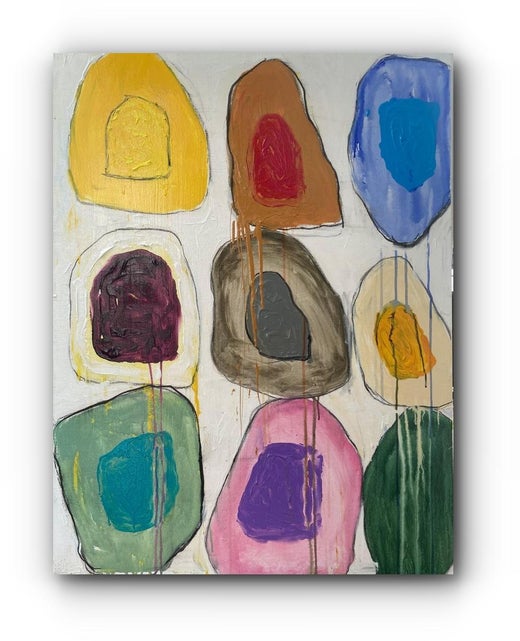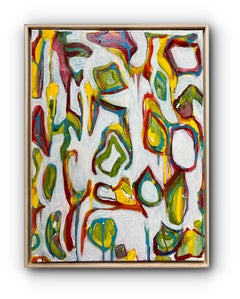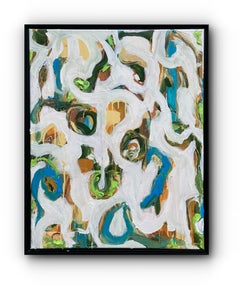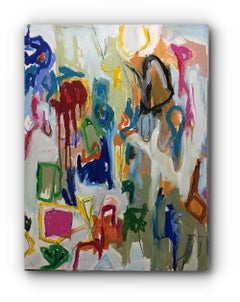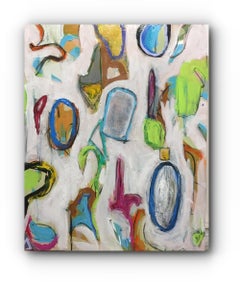G. Campbell LymanOnce and Again (Large)2019
2019
About the Item
- Creator:G. Campbell Lyman (1960, American)
- Creation Year:2019
- Dimensions:Height: 48 in (121.92 cm)Width: 36 in (91.44 cm)Depth: 1.5 in (3.81 cm)
- Medium:
- Movement & Style:
- Period:
- Condition:
- Gallery Location:New Orleans, LA
- Reference Number:1stDibs: LU99434245221
G. Campbell Lyman
G. Campbell Lyman is a prolific collector of works by lesser heralded artists and an accomplished abstract painter in his own right. Lyman’s own abstract paintings and watercolors comprise repeating patterns of irregular circles, rectangles, whorls and cellular forms painted with thick brushstrokes in vivacious hues.
Lyman grew up in New Orleans, where he started collecting and making his art as a teenager. When he was around 30 years old, he began traveling to discover and sell undervalued art, living in various places in the United States and Europe.
Eventually, he returned to New Orleans and opened Guy Lyman Fine Art on the city’s famous Magazine Street. He operated the gallery for several years before moving his business entirely online in the late 2010s. Lyman divides his inventory into four sections: 19th- and early 20th-century art, modern and contemporary art, New Orleans and Louisiana art, and finally, his own creations.
Lyman cites "painterly" painters like Robert Rauschenberg, Sean Scully, Cy Twombly and Julian Schnabel — as well as movements such as Pop art and Abstract Expressionism — as having influenced his work. He is less concerned about the forms on the canvas and more about the paint’s texture, color and line, as well as the negative space around it. He appreciates and creates art that shows the presence of the artist's hand.
Lyman's work is held in art collections from California and Aspen to London and Beirut. He strives to keep his prices affordable for a broader demographic of collectors.
On 1stDibs, find G. Campbell Lyman paintings, drawings, mixed media and more.
You May Also Like
21st Century and Contemporary Abstract Expressionist Abstract Paintings
Canvas, Oil, Acrylic
2010s Abstract Expressionist Abstract Paintings
Canvas, Oil, Acrylic, Pigment
Late 20th Century Abstract Expressionist Abstract Paintings
Canvas, Acrylic, Oil
2010s Abstract Expressionist Abstract Paintings
Oil, Acrylic
2010s Abstract Expressionist Mixed Media
Paper, Oil, Acrylic
2010s Abstract Expressionist Mixed Media
Oil, Acrylic
2010s Abstract Expressionist Abstract Paintings
Canvas, Oil, Acrylic
Early 2000s Abstract Expressionist Abstract Paintings
Canvas, Oil, Acrylic
2010s Abstract Expressionist Abstract Paintings
Canvas, Oil, Acrylic
Early 2000s Abstract Expressionist Abstract Paintings
Canvas, Oil, Acrylic
More From This Seller
View All2010s Abstract Expressionist Abstract Paintings
Lacquer, Charcoal, House Paint, Oil, Acrylic
2010s Abstract Expressionist Abstract Paintings
Lacquer, Charcoal, House Paint, Oil, Acrylic
2010s Abstract Expressionist Abstract Paintings
Oil, Acrylic
2010s Abstract Expressionist Abstract Paintings
Acrylic
2010s Abstract Expressionist Abstract Paintings
Pastel, Acrylic
2010s Abstract Abstract Paintings
Oil, Wood Panel, Acrylic
